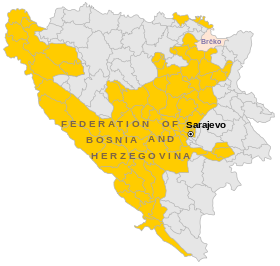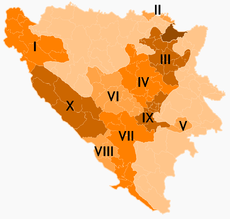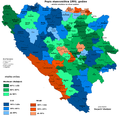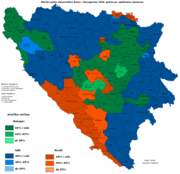Federation of Bosnia and Herzegovina
| Federation of Bosnia and Herzegovina
Federacija Bosne i Hercegovine Федерација Босне и Херцеговине
|
||
|---|---|---|
|
Location of the Federation of Bosnia and Herzegovina (red) inside of Bosnia and Herzegovina (camel) on the European continent (white).
|
||
 Location of the Federation of Bosnia and Herzegovina (yellow) within Bosnia and Herzegovina.1
|
||
| Capital (and largest city) |
Sarajevo | |
| Official language(s) | Bosnian, Croatian and Serbian | |
| Ethnic groups (2002) | Bosniaks: 70% Croats: 28% Serbs: 1% |
|
| Government | Parliamentary system | |
| - | President | Borjana Krišto |
| - | Prime Minister | Mustafa Mujezinović |
| Entity of Bosnia and Herzegovina | ||
| - | Formed | 18 March 1994 |
| - | Recognized in Bosnia and Herzegovina constitution | 14 December 1995 |
| Area | ||
| - | Total | 26,110.5 km2 10,085 sq mi |
| - | Water (%) | N/A |
| Population | ||
| - | 2009 estimate | 2,852,732[1] |
| - | 1996 census | 2,444,6652 |
| - | Density | 117/km2 303.86/sq mi |
| Currency | Convertible Mark (BAM) |
|
| Time zone | CET (UTC+1) | |
| - | Summer (DST) | CEST (UTC+2) |
| Drives on the | right | |
| The Flag of the Federation of Bosnia and Herzegovina and Coat of arms of the Federation of Bosnia and Herzegovina/Hercegovina have been deemed unconstitutional by the Constitutional Court of Bosnia and Herzegovina and were due to be replaced by September. On 31 March 2007, the Constitutional Court placed its decision into the "Official Gazette of Bosnia and Herzegovina" officially removing them. 2006.[2] The federation has not yet adopted a new anthem or coat of arms, but uses the symbols of the central state as a provisional solution.[3] | ||
| 1 | Although the Brčko District is formally held in condominium by both entities simultaneously (the Federation of Bosnia and Herzegovina and the Republika Srpska), it is a de facto third entity, as it has all the same powers as the other two entities and is under the direct sovereignty of BiH.[4][5] | |
| 2 | Refugees abroad included | |
The Federation of Bosnia and Herzegovina listen (Bosnian, Croatian, Serbian: Federacija Bosne i Hercegovine Serbian Cyrillic: Федерација Босне и Херцеговине) is one of the two political entities that compose the sovereign country of Bosnia and Herzegovina (the other entity is the Republika Srpska). The two entities are delineated by the Inter-Entity Boundary Line.
The Federation of Bosnia and Herzegovina is primarily inhabited by Bosniaks and Bosnian Croats, which is why it is informally referred to as the Bosniak-Croat Federation. However, by decision of the Constitutional court in 2001, the Serbs were declared the third constituent ethnic group of the Federation. The same happened to Bosniaks and Bosnian Croats in the Republika Srpska.
The Federation was created by the Washington accords signed on 18 March 1994, which established a Constituent assembly (Ustavotvorna skupština/Ustavotvorbeni Sabor). The Constituent assembly continued its work until October 1996.
The Federation now has its own capital, government, president, parliament, customs and police departments, postal system (in fact, two of them), and airline (BH Airlines). It used to have its own army, the Army of the Federation of Bosnia and Herzegovina, though along with the Army of the Republika Srpska it was fully integrated into Armed Forces of Bosnia and Herzegovina, controlled by the Ministry of Defence of Bosnia and Herzegovina, on 6 June 2006.
Contents |
History
The Federation of Bosnia and Herzegovina was formed by the Washington Agreement of March 1994. Under the agreement, the combined territory held by the Croat and Armija RBiH forces (the Bosnian Croat portion including the Croatian Republic of Herzeg-Bosnia) was divided into ten autonomous cantons. The cantonal system was selected to prevent dominance by one ethnic group over another.
In 1995, Bosnian government forces and Bosnian Croat forces of the Federation of Bosnia and Herzegovina defeated forces of the Autonomous Province of Western Bosnia, and this territory was added to the federation.
By the Dayton Agreement of 1995, the Federation of Bosnia and Herzegovina was defined as one of the two entities of Bosnia and Herzegovina and included 51% of the territory of Bosnia and Herzegovina (another entity, Republika Srpska included 49%).
On 8 March 2000, the Brčko District was formed as an autonomous entity within Bosnia and Herzegovina and it was created from part of the territory of both Bosnian entities. Brčko District is now a shared territory that belongs to both entities.
Discussions about the institutional future of Bosnia and Herzegovina include several options, one of them favored by many Croats being the possible creation of a third, Croatian entity within BIH.
Geography
Boundary
The Inter-Entity Boundary Line (IEBL) that distinguishes Bosnia and Herzegovina's two entities essentially runs along the military front lines as they existed at the end of the Bosnian War, with adjustments (most importantly in the western part of the country and around Sarajevo), as defined by the Dayton Agreement. The total length of the IEBL is approximately 1,080 km. The IEBL is an administrative demarcation and not controlled by the military or police and there is free movement across it.
Cantons
The Federation of Bosnia and Herzegovina is divided into ten cantons (kanton or županija)[6]:

I. Una-Sana, Unsko-sanska županija
II. Posavina, Posavska županija
III. Tuzla, Tuzlanska županija
IV. Zenica-Doboj, Zeničko-dobojska županija
V. Bosnian Podrinje, Bosansko-podrinjska županija
VI. Central Bosnia, Županija Središnja Bosna
VII. Herzegovina-Neretva, Hercegovačko-neretvanska županija
VIII. West Herzegovina, Zapadnohercegovačka županija
IX. Sarajevo, Sarajevska županija
X. Canton 10, Hercegbosanska Županija
Five of the cantons (Una-Sana, Tuzla, Zenica-Doboj, Bosnian Podrinje and Sarajevo) are Bosniak majority cantons, three (Posavina, West Herzegovina and Hercegbosanska) are Croat majority cantons, and two (Central Bosnia and Herzegovina-Neretva) are 'ethnically mixed', meaning there are special legislative procedures for protection of the constituent ethnic groups.
A significant portion of Brčko District was also part of the Federation; however, when the district was created, it became shared territory of both entities, but it was not placed under control of either of the two, and is hence under direct jurisdiction of Bosnia-Herzegovina.
Currently the Federation of Bosnia and Herzegovina has 79 municipalities.
Cities
List of the largest municipalities in Federation of Bosnia and Herzegovina:[note 1][7]
| No. | Name | Population |
|---|---|---|
| 1. | Sarajevo | 304,614 |
| 2. | Tuzla | 174,558 |
| 3. | Zenica | 145,000 |
| 4. | Mostar | 128,488 |
| 5. | Bihać | 105,000 |
| 6. | Travnik | 75,000 |
| 7. | Cazin | 66,881 |
| 8. | Sanski Most | 60,307 |
| 9. | Bosanska Krupa | 58,320 |
| 10. | Zavidovići | 57,164 |
| 11. | Lukavac | 56,830 |
| 12. | Gradačac | 56,378 |
| 13. | Kakanj | 55,857 |
| 14. | Gračanica | 55,000 |
| 15. | Živinice | 54,768 |
| 16. | Tešanj | 52,249 |
| 17. | Srebrenik | 47,938 |
| 18. | Bugojno | 46,630 |
| 19. | Velika Kladuša | 44,350 |
| 20. | Konjic | 43,878 |
| 21. | Maglaj | 43,294 |
| 22. | Goražde | 36,496 |
| 23. | Livno | 32,454 |
| 24. | Odžak | 30,651 |
Demographics
The Federation of Bosnia and Herzegovina comprises 51% of the land area of Bosnia and Herzegovina, and is home to around 60% of the country's total population. All data dealing with population, including ethnic distributions, are subject to considerable error because of the lack of official census figures.[8]
| Ethnic Composition | |||||||||||||
| Year | Muslims | % | Croats | % | Serbs | % | Others | % | Total | ||||
|---|---|---|---|---|---|---|---|---|---|---|---|---|---|
| 1991 | 1,423,593 | 52.3% | 594,362 | 21.9% | 478,122 | 17.6% | 223,997 | 8.2% | 2,720,074 | ||||
| 1996 | 1,773,566 | 72.5% | 556,289 | 22.8% | 56,618 | 2.3% | 58,192 | 2.4% | 2,444,665 | ||||
| note1:The vast majority of Muslims by nationality today consider themselves Bosniaks. note2: "Other" is mainly people who declared themselves as Yugoslavs |
|||||||||||||
Total population estimates...
- December 31st 2003. 2,323,339 total, of which 1,099,233 male and 1,224,106 female
- December 31st 2005. 2,323,992 total, of which 1,137,180 male and 1,186,812 female
- June 30th 2008. 2,327,195 total, of which 1,138,757 male and 1,188,438 female.
 Ethnic composition in 1961 |
 Ethnic composition in 1981 |
 Ethnic composition in 1991 |
 Ethnic composition estimate in 2006 |
Government and politics
There is a President of the Federation, and two Vice-presidents, identical to Republika Srpska.
From 2003 until 2007 the president was Croat, Niko Lozančić of the HDZ party, whereas both the Bosniak (Sahbaz Džihanović) and Serb (Desnica Radivojević) Vice-presidents came from the SDA party.
The current President is Croat, Borjana Krišto (HDZ), the Bosniak Vice-President is Mirsad Kebo (SDA) and the Serb Vice-President is Spomenka Mičić (SBiH).
The Cabinet has 16 members with carefully delineated nationality quotas. There are 8 Bosniak, 5 Croat and 3 Serb ministers in the current Government. As of June, 2009, the Prime Minister is Mustafa Mujezinović, Bosniak of the SDA.
The Parliament consists of two houses, the House of Representatives and the House of Peoples. The House of Representatives is an elected body of 98 MPs, whereas the House of Peoples consists of Representatives delegated by the cantonal parliaments.
Interestingly, a number of institutions in the Federation still function under the 'componental' system; there is a Croat postal system and a Bosniak postal system, a Croat telecom and a Bosniak telecom, a Croat army component and a Bosniak army component; however, recently many systems have been merged into one single public company, e.g. the pension system or the public broadcasting company of the Federation. Each of the cantons also has broad-ranging authorities, such as having its own courts and police forces.
Federation currently has its own entity police force. Police systems including entity ministries of security of both entities are to be united by 2010 into a new state-level Ministry of Security and entity level police forces are to abolished and replaced with state level police force under regional control.
Armies of both entities are under the control of a new state-level Ministry of Defense as of 1 January 2006.
Gallery
|
Počitelj - Old village near Mostar. |
Mostar - Stari Most (Old bridge). |
Sarajevo - View from east. |
Pliva Waterfall. |
 Troglav. |
 Vrelo Bosne. |
See also
Notes
- ↑ The town of Brčko is part of the Brčko District, which is part of both, Federation of Bosnia and Herzegovina and Republika Srpska.
References
- ↑ Federation Office of Statistics
- ↑ Constitutional Court of Bosnia and Herzegovina
- ↑ http://www.javno.com/en/world/clanak.php?id=164758
- ↑ Office of High Representative in Bosnia and Herzegovina
- ↑ Office of High Representative in Bosnia and Herzegovina
- ↑ Structure of Federation of Bosnia and Hezegovina:
- ↑ "Estimation total number of present population by age, sex and cantons and municipality, 30 June 2008" (PDF). Federal Office of Statistics, Federation of Bosnia and Herzegovina. http://www.fzs.ba/Dem/ProcPrist/stalno.pdf. Retrieved 2009-08-10.
- ↑ http://en.wikipedia.org/wiki/Image:FederationB-HPopInfo.jpg
External links
- Website of the Federation Government
- Parliament of the Federation
- Website for persons unaccounted for in connection with the conflict on the territory of Bosnia and Herzegovina, International Committee of the Red Cross.
|
|||||||||||||||||||||||||||||||||
|
||||||||||||||||||||||||||||||||||||||||||||||||||||||||||